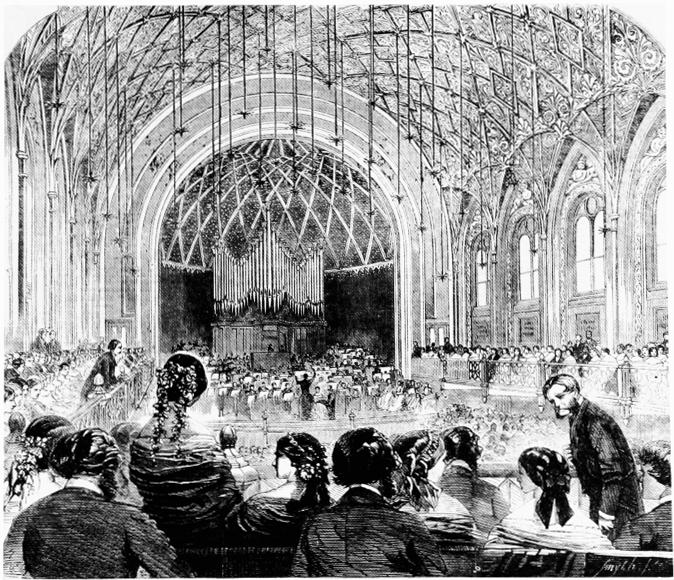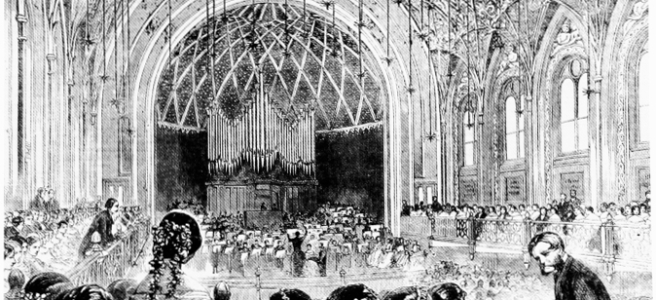John Addington Symonds pointedly states in his Memoirs, “I never really enjoy a cathedral without music” (288). This testimonial is supported by his subtle nods of appreciation for music throughout his writing, starting with his earliest recollections and vivid descriptions of church hymns from his childhood. He might have extended this declaration of musical appreciation to choristers, and especially to his first love, Willie Dyer, whose ethereal renditions of the masses of great composers moved the author as a young man. However, one cannot help but notice the lack of music in Symonds’s subsequent amours, which I shall explore later. Music and musical settings played a nuanced role in his personal appreciation of aesthetics, and I shall consider how this features in the story of Willie. I would also like to explore some noteworthy composers and pieces Symonds discusses.
In Symonds’s early recollections of churchgoing as a young man, it is apparent that music, along with art and architecture, played an important role in his developing aesthetics. In this passage, he describes how music in the Bristol Cathedral deeply affected him:
The organ was playing and the choristers were singing. Some chord awoke in me then, which has gone on thrilling through my lifetime and has been connected with the deepest of my emotional experiences. […] The voices of choiring men and boys, the sobbing antiphones and lark-like soaring of clear treble notes into the gloom of Gothic arches, the thunder of the labouring diapasons, stir in me that old deep-centred innate sentiment (65).
An additional note of interest is the fondness with which he describes the voices of the choristers, which would play an important role in his later relationship with Willie. It also seems that the glory of the power of all the voices in a choir and the accompanying organ complemented the architectural aesthetics he appreciated in church. Following on how music complemented his perception of architecture, he explains,
Without this living accompaniment [of music] and commentary, architecture seems to me cold and dead. Are the harmonic ratios of form and sound really so sympathetic as mutually to elucidate each other? Or is it a matter of association: the religious purpose and solemn character of organ music tuning our mind to the proper key for comprehending sacred architecture? (288).
The musical grandeur of his early experience in church leaves a lasting impression on Symonds, as he is able to capture the same majesty and feeling in his Memoirs decades later.
Musical encounters distinguish and accompany a particularly important point in his life: his first love for Willie Dyer. On one morning at church when Symonds was a student at Harrow, the voice of a certain chorister captured his attention:
Music and the grandeur of Gothic aisles, the mystery of winter evenings in cathedral choirs, when the tumultuous vibrations of the organ shook the giant windows and made the candles in their sconces tremble, took from [Willie] a poetry that pierced into my heart and marrow (158).
In Symonds’s reflections on Willie’s voice, he writes,
His voice charmed me by its sharp ethereal melancholy. In timbre and quality it had something of a wood instrument; and because of my love for it, I have ever since been sensitive to the notes of hautbois and clarionette (156).
This leads to his passionate relationship to the singer, which was pivotal in his personal development; he writes that their eventual meeting gave rise to the birth of his real self (157). The combination of Willie’s voice and his ability to interpret such pieces captivated the author’s imagination. Music was a gateway for him to see the beauty in Willie. As an adult, Symonds directly points to the qualities of Willie’s musical talents that touched him as a young man. There is a clear nostalgia in his writing, when he states that he is still “sensitive” to the timbre of a wood instrument, which reminds him of the chorister’s voice.
An interesting point to consider is the lack of fervent descriptions of music and its role in Symonds’s later relationships. For example, in his descriptions of Alfred Brooke or Norman, the author mainly concentrates on their physical or intellectual beauty. In his recollections of Alfred, he describes his love for him in a series of prose dithyrambs, which focus on Alfred’s attractiveness. Years later, this physical longing is still in command of Symonds’s reflections in the Memoirs. For Norman, Symonds insists that this love played an important role in his literary development. He writes that Norman liberated his intellect and will, and their meeting dates to the beginning of his own period of great literary activity (381). His later amours have a profound impact on his artistic development, and other qualities of these relationships dominate Symonds’s recollections. However, he doesn’t make any references to musical works or musical settings that make him sentimental when he reflects on these other loves. Instead of mentions of hymns, he often dedicates Ancient Greek and Latin verses to the memory of these men; in place of descriptions of a church choir, the settings at Oxford and the College Green mark his later loves. Consequently, music does not have a central role in the reminiscences of Alfred or Norman as it did with Willie. When Symonds first met the chorister, he initially noticed the captivating qualities of his voice, which was an entryway into a further passionate relationship. Symonds’s love for other young men lacks this important feature. The image of the chorister subsequently made the author associate church hymns and masses with Willie’s beauty, which was not only physical or intellectual, but also musical.
Finally, I would like to look at some composers and pieces that Symonds notes in his Memoirs. The earliest mentions are amid recollections about Dyer, where he lists church masses that moved him. Three soprano solos are forever impressed in his memory of the chorister’s voice, one of them being Mozart’s Kyrie of the Coronation Mass (158). The other two solos include the recitative from Handel’s Messiah, where he also mentions the “Pastoral Symphony,” the “Chorus of the Gloria,” and Louis Spohr’s “As pants the hart” (158). Other later mentions of church music include Mendelssohn’s oratorio, Elijah, which he listened to during his travels in Switzerland (222). Later, he writes about Gioachio Rossini’s “La Carità,” which is the third piece in the Trois choeurs religieux (310). Symonds’s descriptions of hearing this composer’s music lead him into sentimental reflections, in which he writes,
None of Rossini’s cadences are more melting than their violets, none of his crescendos more passionate than their reds, and the sehnsucht of his melody seemed to be written in glowing characters of green and gold and blue (310).
The pieces that Symonds heard in concert halls and opera houses are described as follows:
With closed eyes I sat listening to the divine melodies of Mozart, the symphonies of Beethoven, to Gounod, Bellini, Donizetti, Verdi; to Rubinstein’s impassioned piano-forte playing, and Piatti’s violoncello, Joachim’s violin; to the voices of Trebelli and Titiens, of Giuglini, and Patti, and Pauline Lucca (256-7).

Although his mentions of music in his Memoirs are often sparse, one can still sense the nostalgia Symonds felt for it. Musical settings cultivated his appreciation of architecture and aesthetics. He draws parallels between harmonies and architectural ratios, believing that the two must go hand in hand. Such settings also played an important part in his first relationship with Willie. The chorister not only offered physical beauty, but also musical splendor, which Symonds’s later amours lacked. Symonds puts the effect of music best in his own words:
And Music? Ah, that is the best anodyne of all. In music we emerge from opium fumes, and narcotize the soul into a hypnotism which is spiritual (317).
Works Cited:
Symonds, John Addington. Regis, Amber K. The Memoirs of John Addington Symonds: A Critical Edition. London: Palgrave Macmillan, 2016.

